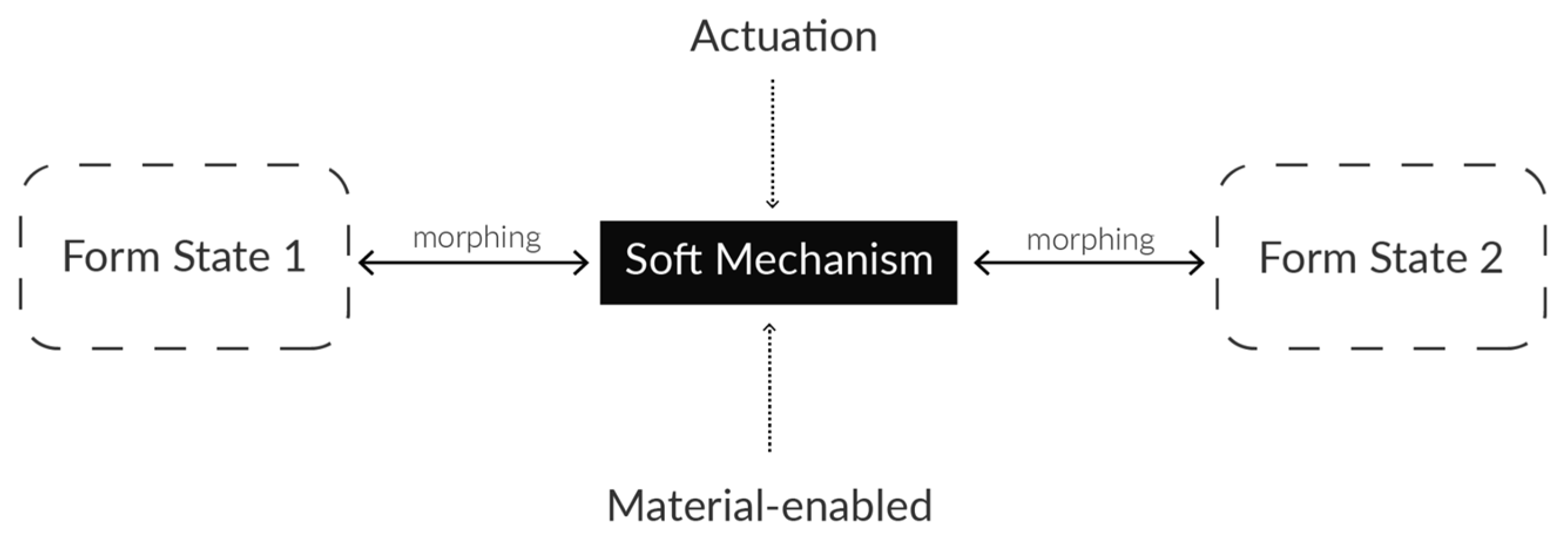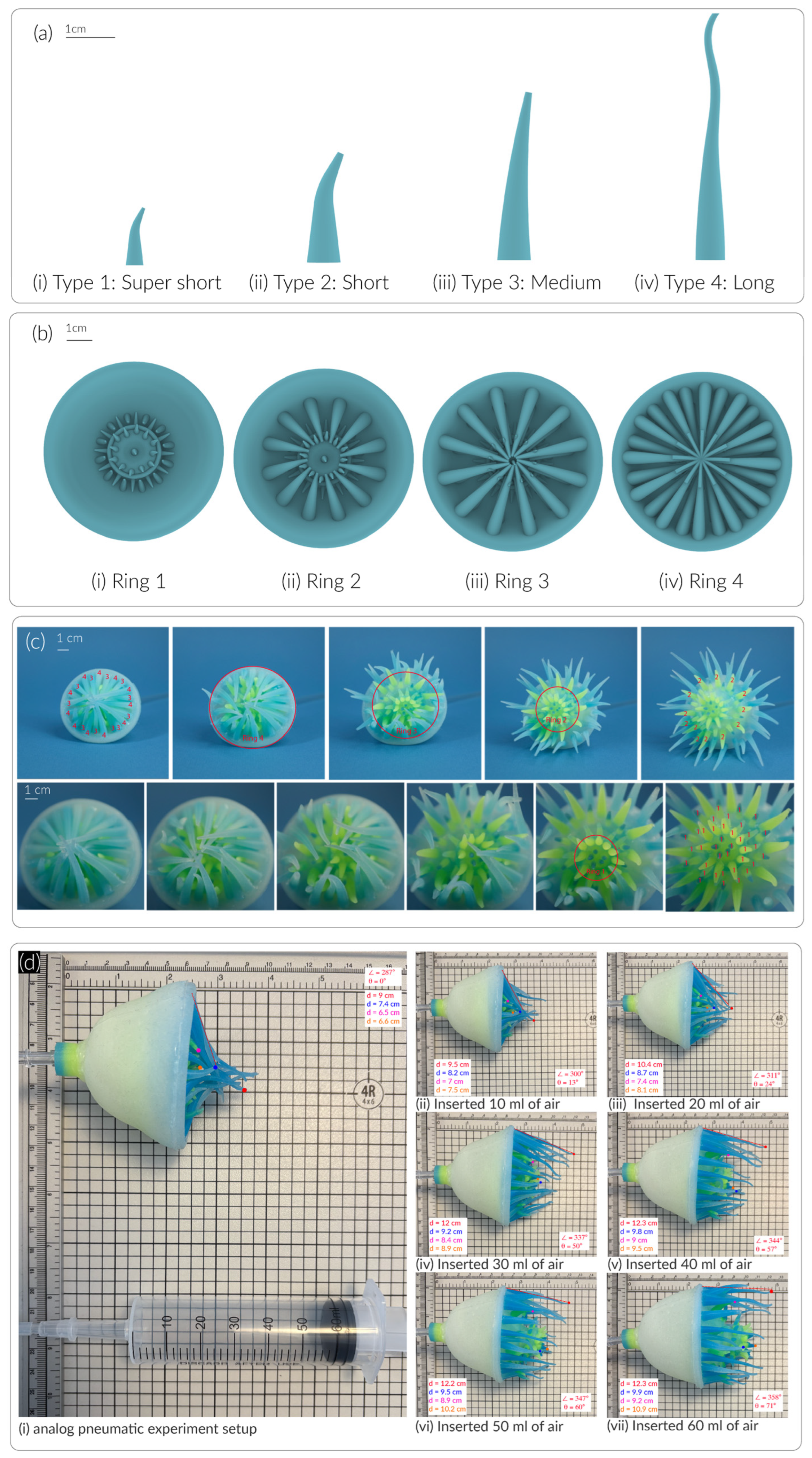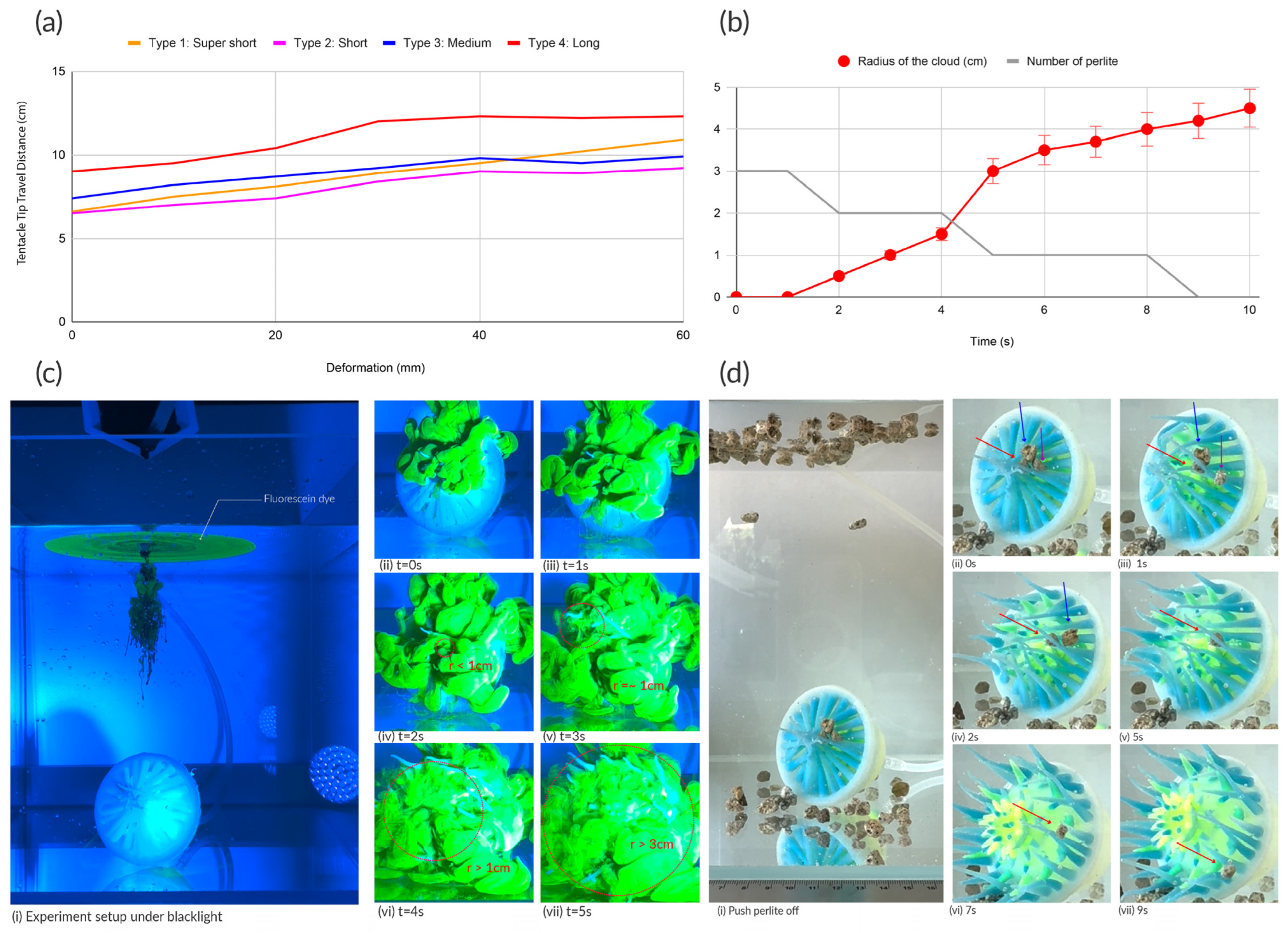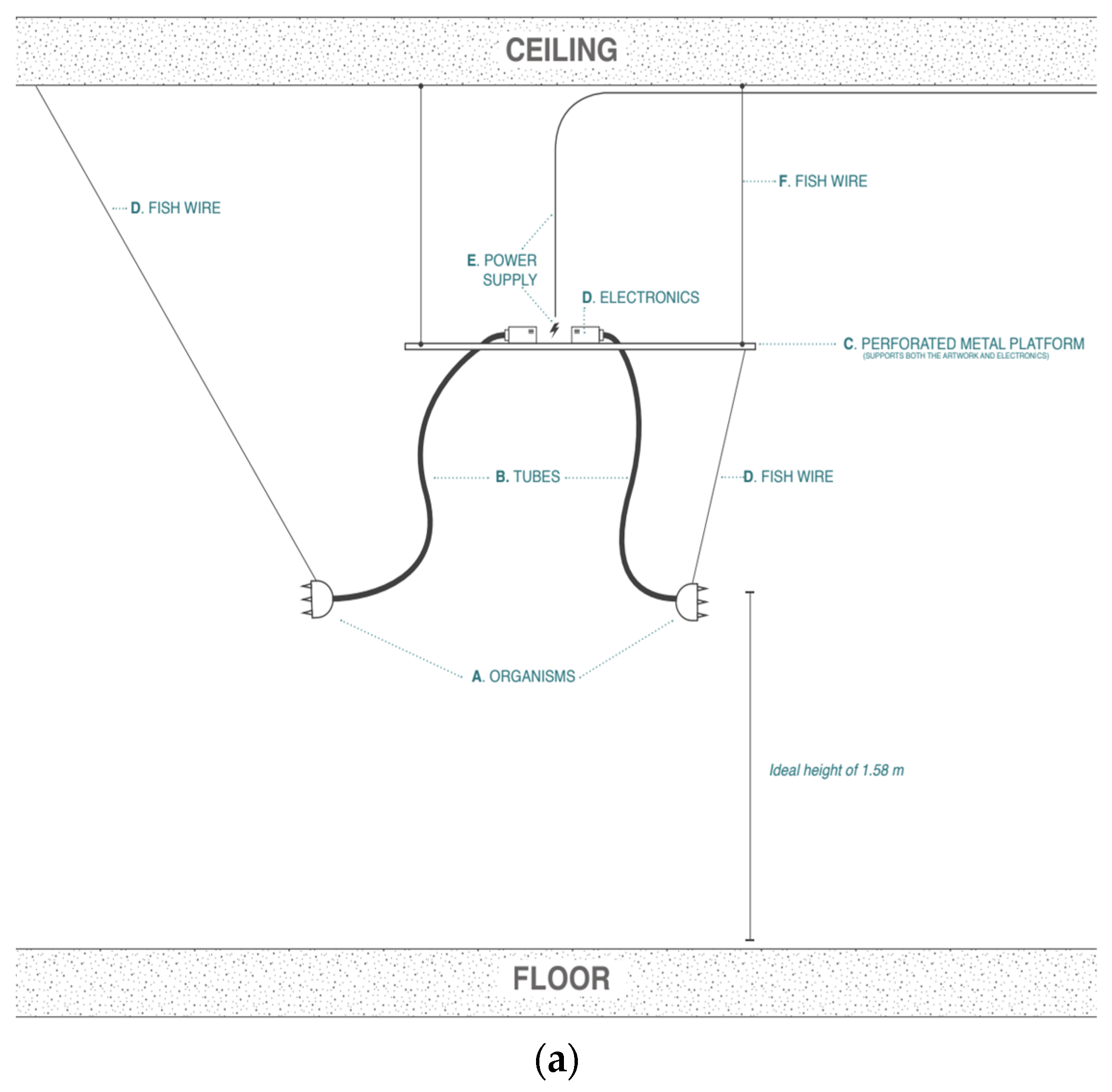Cnidaria-Inspired Morphing Mechanism for Underwater Robot: A Soft Tectonics Approach
Abstract
1. Introduction
- (1)
- A state of the art of soft robot that mimics a complex morphology;
- (2)
- A state of knowledge via a new design guideline—soft tectonics;
- (3)
- A demonstrated experimental result with precise control of inflation and deflation, laying the groundwork for future studies;
- (4)
- The validation of our proposed method in a small-scale water tank.
2. Materials and Methods
2.1. Soromone: Material Overview
2.1.1. Soft Actuator
2.1.2. Control System
- (i)
- An Adafruit CRICKIT (Adafruit Industries, Brooklyn, NY, USA);
- (ii)
- An Adafruit Circuit Playground Express (Adafruit Industries, Brooklyn, NY, USA);
- (iii)
- A 6V air valve (ZhiRongHuaGuan, Dongwan, China);
- (iv)
- Two 4.5 V 2.5 LPM air pump DC motors (ZhiRongHuaGuan, Dongwan, China);
- (v)
- An 5V 2A AC/DC power adapter (Adafruit Industries, Brooklyn, NY, USA).
2.1.3. Experiment Setup
2.2. Soft Tectonics: A Method for Soft Robotics Design
2.2.1. Traditional Biomimicry Design and Fabrication
2.2.2. Soft Tectonics Design Principle for Soft Robotics
2.2.3. Manufacturing Method
- Biological-expression oriented
- Material-driven fabrication
- Geometry
- Integration
2.3. Design and Manufacturing of the Soromone: An Example of Soft Tectonics Approach
2.3.1. The Design of Soromone
2.3.2. The Manufacturing of Soromone
3. Results
3.1. Characteristics of Soromone
3.2. Morphing Performance and Behavior
3.2.1. Electronic Pneumatic Actuation
3.2.2. Pneumatic vs. Hydraulic
3.2.3. Task Experiment
4. Discussion and Conclusions
5. Patents
Funding
Institutional Review Board Statement
Informed Consent Statement
Data Availability Statement
Acknowledgments
Conflicts of Interest
References
- Butler, D. A world where everyone has a robot: Why 2040 could blow your mind. Nature 2016, 530, 398–401. [Google Scholar] [CrossRef]
- Bao, G.; Fang, H.; Chen, L.; Wan, Y.; Xu, F.; Yang, Q.; Zhang, L. Soft robotics: Academic insights and perspectives through bibliometric analysis. Soft Robot. 2018, 5, 229–241. [Google Scholar] [CrossRef]
- Wada, K.; Shibata, T. Living with Seal Robots—Its Sociopsychological and Physiological Influences on the Elderly at a Care House. IEEE Trans. Robot. 2007, 23, 972–980. [Google Scholar] [CrossRef]
- Webster, R.J.; Okamura, A.M.; Cowan, N.J.; Taylor, R.H. An Active Cannula for Bio-Sensing and Surgical Intervention. U.S. Patent No. 8,152,756, 10 April 2012. [Google Scholar]
- Beatty, R.; Mendez, K.L.; Schreiber, L.H.J.; Tarpey, R.; Whyte, W.; Fan, Y.; Robinson, S.T.; O’Dwyer, J.; Simpkin, A.J.; Tannian, J.; et al. Soft robot–mediated autonomous adaptation to fibrotic capsule formation for improved drug delivery. Sci. Robot. 2023, 8, eabq4821. [Google Scholar] [CrossRef]
- Arfaee, M.; Vis, A.; Bartels, P.A.A.; van Laake, L.C.; Lorenzon, L.; Ibrahim, D.M.; Zrinscak, D.; Smits, A.I.P.M.; Henseler, A.; Cianchetti, M.; et al. A soft robotic total artificial hybrid heart. Nat. Commun. 2025, 16, 5146. [Google Scholar] [CrossRef] [PubMed]
- Galloway, K.C.; Becker, K.P.; Phillips, B.; Kirby, J.; Licht, S.; Tchernov, D.; Wood, R.J.; Gruber, D.F. Soft robotic grippers for biological sampling on deep reefs. Soft Robot. 2016, 3, 23–33. [Google Scholar] [CrossRef]
- Yang, G.-Z.; Bellingham, J.; Dupont, P.E.; Fischer, P.; Floridi, L.; Full, R.; Jacobstein, N.; Kumar, V.; McNutt, M.; Merrifield, R.; et al. The grand challenges of science robotics. Sci. Robot. 2018, 3, eaar7650. [Google Scholar] [CrossRef] [PubMed]
- Aracri, S.; Giorgio-Serchi, F.; Suaria, G.; Sayed, M.E.; Nemitz, M.P.; Mahon, S.; Stokes, A.A. Soft robots for ocean exploration and offshore operations: A perspective. Soft Robot. 2021, 8, 625–639. [Google Scholar] [CrossRef] [PubMed]
- Katzschmann, R.K.; DelPreto, J.; MacCurdy, R.; Rus, D. Exploration of underwater life with an acoustically controlled soft robotic fish. Sci. Robot. 2018, 3, eaar3449. [Google Scholar] [CrossRef]
- Brooker, R.M.; Feeney, W.E.; Sih, T.L.; Ferrari, M.C.O.; Chivers, D.P. Comparative diversity of anemone-associated fishes and decapod crustaceans in a Belizean coral reef and seagrass system. Mar. Biodivers. 2019, 49, 2609–2620. [Google Scholar] [CrossRef]
- Levy, N.; Marques, J.A.; Simon-Blecher, N.; Bourne, D.G.; Doniger, T.; Benichou, J.I.C.; Lim, J.Y.; Tarazi, E.; Levy, O. Ecosystem transplant from a healthy reef boosts coral health at a degraded reef. Nat. Commun. 2024, 15, 10033. [Google Scholar] [CrossRef]
- Baumgarten, S.; Simakov, O.; Esherick, L.Y.; Liew, Y.J.; Lehnert, E.M.; Michell, C.T.; Li, Y.; Hambleton, E.A.; Guse, A.; Oates, M.E.; et al. The genome of Aiptasia, a sea anemone model for coral symbiosis. Proc. Natl. Acad. Sci. USA 2015, 112, 11893–11898. [Google Scholar] [CrossRef]
- Wang, T.; Joo, H.-J.; Song, S.; Hu, W.; Keplinger, C.; Sitti, M. A versatile jellyfish-like robotic platform for effective underwater propulsion and manipulation. Sci. Adv. 2023, 9, eadg0292. [Google Scholar] [CrossRef] [PubMed]
- Wu, M.; Afridi, W.H.; Wu, J.; Afridi, R.H.; Wang, K.; Zheng, X.; Wang, C.; Xie, G. Octopus-Inspired underwater soft robotic gripper with crawling and swimming capabilities. Research 2024, 7, 0456. [Google Scholar] [CrossRef]
- Fras, J.; Noh, Y.; Macias, M.; Wurdemann, H.; Althoefer, K. Bio-inspired octopus robot based on novel soft fluidic actuator. In Proceedings of the IEEE International Conference on Robotics and Automation (ICRA), Brisbane, Australia, 21–25 May 2018; pp. 1583–1588. [Google Scholar]
- Ren, Z.; Hu, W.; Dong, X.; Sitti, M. Multi-functional soft-bodied jellyfish-like swimming. Nat. Commun. 2019, 10, 2703. [Google Scholar] [CrossRef] [PubMed]
- Lee, J.; Yoon, Y.; Park, H.; Choi, J.; Jung, Y.; Ko, S.H.; Yeo, W.-H. Bioinspired soft robotic fish for Wireless underwater control of gliding locomotion. Adv. Intell. Syst. 2022, 4, 2100271. [Google Scholar] [CrossRef]
- Zang, H.; Liao, B.; Lang, X.; Zhao, Z.-L.; Yuan, W.; Feng, X.-Q. Bionic torus as a self-adaptive soft grasper in robots. Appl. Phys. Lett. 2020, 116, 023701. [Google Scholar] [CrossRef]
- Qi, Q.; Xiang, C.; Ho, V.A.; Rossiter, J. A sea-anemone-inspired, multifunctional, bistable gripper. Soft Robot. 2022, 9, 1040–1051. [Google Scholar] [CrossRef] [PubMed]
- Wang, Q.; Wu, Z.; Huang, J.; Du, Z.; Yue, Y.; Chen, D.; Li, D.; Su, B. Integration of sensing and shape-deforming capabilities for a bioinspired soft robot. Compos. Part B Eng. 2021, 223, 109116. [Google Scholar] [CrossRef]
- Yang, J.; Ren, C.; Yang, C.; Wang, Y.; Wan, S.; Kang, R. Design of a flexible capture mechanism inspired by sea anemone for non-cooperative targets. Chin. J. Mech. Eng. 2021, 34, 77. [Google Scholar] [CrossRef]
- Youssef, S.M.; Soliman, M.; Saleh, M.A.; Mousa, M.A.; Elsamanty, M.; Radwan, A.G. Underwater Soft Robotics: A Review of Bioinspiration in Design, Actuation, Modeling, and Control. Micromachines 2022, 13, 110. [Google Scholar] [CrossRef]
- Abdai, J.; Miklósi, A. (Eds.) An Introduction to Ethorobotics: Robotics and the Study of Animal Behaviour, 1st ed.; Routledge: Oxfordshire, UK, 2025. [Google Scholar]
- Marchese, A.D.; Katzschmann, R.; Rus, D.L. A recipe for soft fluidic elastomer robots. Soft Robot. 2015, 2, 7–25. [Google Scholar] [CrossRef]
- Xavier, M.S.; Tawk, C.D.; Zolfagharian, A.; Pinskier, J.; Howard, D.; Young, T.; Lai, J.; Harrison, S.M.; Yong, Y.K.; Bodaghi, M.; et al. Soft pneumatic actuators: A review of design, fabrication, modeling, sensing, control and applications. IEEE Access 2022, 10, 59442–59485. [Google Scholar] [CrossRef]
- Yordanova, N. A new approach to the concept of tectonics. In Structures and Architecture-Bridging the Gap and Crossing Borders; CRC Press: Boca Raton, FL, USA, 2019; pp. 1056–1063. [Google Scholar]
- Thomsen, M.R.; Bech, K.; Tamke, M.; Glynn, R.; Sheil, B. THAW: Imagining a Soft Tectonics. In Fabricate: Making Digital Architecture; DGO-Digital Original; UCL Press: London, UK, 2011; pp. 27–30. [Google Scholar] [CrossRef]
- Dong, X.; Luo, X.; Zhao, H.; Qiao, C.; Li, J.; Yi, J.; Yang, L.; Oropeza, F.J.; Hu, T.S.; Xu, Q.; et al. Recent advances in biomimetic soft robotics: Fabrication approaches, driven strategies and applications. Soft Matter 2022, 18, 7699–7734. [Google Scholar] [CrossRef] [PubMed]
- Howell, L.L.; Olsen, B.M.; Magleby, S.P. Part Three Synthesis Of Compliant Mechanisms. In Handbook of Compliant Mechanisms; John Wiley & Sons, Incorporated: Hoboken, NJ, USA, 2013; p. 151. [Google Scholar]
- OpenStax. Phylum Cnidaria (Section 5.8.3). General Biology 2e. Biology LibreTexts. 2022. Available online: https://bio.libretexts.org/Bookshelves/Introductory_and_General_Biology/General_Biology_2e_(OpenStax)/05:_Unit_V-_Biological_Diversity/5.08:_Invertebrates/5.8.03:_Phylum_Cnidaria (accessed on 26 October 2025).
- Ames, C.L. Medusa: A review of an ancient cnidarian body form. In Marine Organisms as Model Systems in Biology and Medicine; Springer: Cham, Swizterland, 2018; pp. 105–136. [Google Scholar] [CrossRef]
- Ikmi, A.; Steenbergen, P.J.; Anzo, M.; McMullen, M.R.; Stokkermans, A.; Ellington, L.R.; Gibson, M.C. Feeding-dependent tentacle development in the sea anemone Nematostella vectensis. Nat. Commun. 2020, 11, 4399. [Google Scholar] [CrossRef] [PubMed]
- Su, H.; Hou, X.; Zhang, X.; Qi, W.; Cai, S.; Xiong, X.; Guo, J. Pneumatic Soft Robots: Challenges and Benefits. Actuators 2022, 11, 92. [Google Scholar] [CrossRef]











| Ring | Radius (mm) | Tentacle Type | Length (mm) | Distance Between Tentacles (mm) |
|---|---|---|---|---|
| Ring 1 | 14 | Type I Super short | 10 | 7.3 |
| Ring 2 | 23 | Type II Short | 20 | 12 |
| Ring 3 | 28 | Type III Medium | 30 | 14.7 |
| Ring 4 | 32 | Type IV Long | 45 | 16.8 |
| Name of the Elements | Weight | Weight Percentage | Thickness | Surface Area | Mass |
|---|---|---|---|---|---|
| Ectoderm | 20 g | ~39% | 2 mm | 72 cm2 | 15.6 cm3 |
| Mesoglea | 7.5 g | ~15% | Varied | 58 cm2 | 7.2 cm3 |
| Endodern | 10.5 g | ~ 20% | 2 mm | 50 cm2 | 9.9 cm3 |
| Tentacles | ~12 g | ~24% | Varied | Varied | Varied |
| Soromone | 51 g | 100% | - | - | - |
| States | Ectoderm | Mesoglea | Endodern | Cavity |
|---|---|---|---|---|
| Closed | 72 cm2 | 58 cm2 | 50 cm2 | 37.5 cm3 |
| Open | 80 cm2 | 58 cm2 | 52 cm2 | 97.5 cm3 |
| Project (Year) | Actuator Fabrication Method | Material | Number of Tentacle Types | Number of Tentacle Rings | Performance | Test Environment | Reported Durability |
|---|---|---|---|---|---|---|---|
| Bionic torus (2020) [19] | Double-layered cylindrical tube of a torus | Thermoplastic-rubber with sealed liquid | N/A | N/A | Soft torus gripping mimics the hunting process of a sea anemone | In air | N/A |
| RetracTip (2022) [20] | An array of rigid pins distributed on a spherical membrane | 3D printed rigid pins as tentacles, bistable dome membranes | 1 | 4 | Tentacles and retract muscle gripping mimics sea anemones- preying behavior | In air | N/A |
| Magnetic soft robot (2021) [21] | Four tentacles on a hollow body | Magnetic NdFeB/Ecoflex composites | 1 | 1 | Tentacles sense water flow, and the hollow body mimics a sea anemone’s shrinkable body. | In water | N/A |
| Continuum arm (2021) [22] | SMA tendon wire | Silicone, wire, spring, photosensitive resin 3D-printed skeleton | 1 | 1 (r = 60 mm) | Tentacles gripping | In air | N/A |
| Soromone (2025) [this paper] | Soft tectonics (three layers of membranes with 60 tentacles) | Silicone | 4 | 4 (see Table 1) | Soromone’s mouth opening/closing mimic sea anemone’s tentacle wiggling behavior and feeding movement | In air and water | ≥4.11 × 104 cycles |
Disclaimer/Publisher’s Note: The statements, opinions and data contained in all publications are solely those of the individual author(s) and contributor(s) and not of MDPI and/or the editor(s). MDPI and/or the editor(s) disclaim responsibility for any injury to people or property resulting from any ideas, methods, instructions or products referred to in the content. |
© 2025 by the author. Licensee MDPI, Basel, Switzerland. This article is an open access article distributed under the terms and conditions of the Creative Commons Attribution (CC BY) license (https://creativecommons.org/licenses/by/4.0/).
Share and Cite
Yu, Y. Cnidaria-Inspired Morphing Mechanism for Underwater Robot: A Soft Tectonics Approach. Sensors 2025, 25, 6780. https://doi.org/10.3390/s25216780
Yu Y. Cnidaria-Inspired Morphing Mechanism for Underwater Robot: A Soft Tectonics Approach. Sensors. 2025; 25(21):6780. https://doi.org/10.3390/s25216780
Chicago/Turabian StyleYu, Yin. 2025. "Cnidaria-Inspired Morphing Mechanism for Underwater Robot: A Soft Tectonics Approach" Sensors 25, no. 21: 6780. https://doi.org/10.3390/s25216780
APA StyleYu, Y. (2025). Cnidaria-Inspired Morphing Mechanism for Underwater Robot: A Soft Tectonics Approach. Sensors, 25(21), 6780. https://doi.org/10.3390/s25216780






